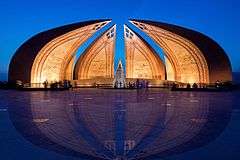Pakistan Monument
| Pakistan Monument | |
|---|---|
| یادبود پاکستان | |
 Pakistan Monument | |
| General information | |
| Type | Public monument |
| Location | Islamabad, Pakistan |
| Coordinates | 33°41′36″N 73°04′06″E / 33.69345°N 73.068309°E |
| Construction started | 25 May 2004 |
| Completed | 23 March 2007 |
| Owner | Ministry of Culture |
| Landlord | Capital Development Authority |
| Design and construction | |
| Architect | Arif Masoud |
| Engineer | Syed Mahmud Khalid |
| Structural engineer | Mushtaq & Bilal |
| Other designers | Khizar Hayat Asghar |
| Main contractor | Universal Corporation |
The Pakistan Monument (Urdu: یادبود پاکستان) is a national monument and heritage museum located on the western Shakarparian Hills in Islamabad, Pakistan. The monument was constructed to symbolize the unity of the Pakistani people. Its elevation makes the monument visible from across the Islamabad-Rawalpindi metropolitan area and is a popular tourist destination.[1]
Structure
Covering a total area of 2.8 hectares, the monument is shaped as a blooming flower petal-shaped structure built of granite, with the inner walls of the petals inscribed with the outlines of Lahore Fort, Badshahi Mosque, Khyber Pass and Minar-e-Pakistan. The monument opens onto a marble terrace providing a bird's-eye view of Islamabad City.[2] The four main petals of the monument represent the four provinces of Balochistan, Khyber-Pakhtunkhwa, Punjab, and Sindh, while the three smaller petals represent the three territories of Gilgit-Baltistan, Azad Jammu & Kashmir and the Tribal Areas.[3] The central platform is made in the shape of a five-pointed star which is surrounded by a water body. A metallic crescent surrounding the star is inscribed with sayings of Muhammad Ali Jinnah and poetry of Allama Iqbal.
Museum
Adjoining the monument is the Pakistan Monument Museum, which includes a wax museum depicting important events leading to the Pakistan Movement. Furthermore, the facilities includes a reference library, audio-visual archive, conference hall along with a 62-seat capacity auditorium known as Panorama Hall.[4] The complex receives on average received 1500 tourists per day totalling at 0.57 million visitors in 2015.[5] From air the monument looks like a star (center) and a crescent moon (formed by walls forming the petals), these represent the star and crescent on Pakistan's flag.[6] The foundation stone was laid on 25 May 2004, completed in 2006 and inaugurated on 23 March 2007 by President General Pervez Muaharaf.[7]
Conception
The plan for a national monument was first envisioned in 2005 by Uxi Mufti, son of Mumtaz Mufti.[8] The idea was later adopted by Ministry of Culture led by Hamad Kashif and in 2005 the Pakistan Council of Architects & Town Planners organised a national monument design competition based around the theme of signifying strength, unity and dedication of the people of Pakistan into an icon representing an independent and free nation.[9] From a total of 21 submissions, 3 were short-listed. The final design proposed by Arif Masoud was selected.[10]
Gallery
 Moon at Monument
Moon at Monument Monument
Monument Pakistan Monument by M Amir Mir
Pakistan Monument by M Amir Mir Crescent moon over Monument
Crescent moon over Monument Evening at Monument
Evening at Monument Central platform
Central platform Gardens at Pakistan Monument Islamabad
Gardens at Pakistan Monument Islamabad An entrance gate leading to the monument
An entrance gate leading to the monument Pakistan Monument Museum
Pakistan Monument Museum

 Moon over arches
Moon over arches Pakistan Monument at Night
Pakistan Monument at Night Monument Arches
Monument Arches Sunset at Monument
Sunset at Monument- View of the monument at night
See also
References
- ↑ "National Monument: Structure reflects history of Pakistan - The Express Tribune". The Express Tribune. 2013-08-29. Retrieved 2016-06-13.
- ↑ InpaperMagazine, From (2011-02-26). "Pakistan National Monument: Reliving history". www.dawn.com. Retrieved 2016-06-13.
- ↑ Planet, Lonely. "Pakistan Monument - Lonely Planet". Lonely Planet. Retrieved 2016-06-13.
- ↑ "Dailytimes | Pakistan Monument Museum attracts people". dailytimes.com.pk. Retrieved 2016-06-13.
- ↑ "Visiting Pakistan Monument no more free now". The Nation. Retrieved 2016-06-13.
- ↑ "RIS students visit Pakistan Monument". www.thenews.com.pk. Retrieved 2016-06-13.
- ↑ Khaleeq Kiani (2006) Rs67bn new schemes approved. Dawn (newspaper). 24 August. Retrieved on 23 March 2008.
- ↑ http://www.dailytimes.com.pk/default.asp?page=2010\03\27\story_27-3-2010_pg11_1
- ↑ Ministry of Culture, Pakistan Archived 2007-11-16 at the Wayback Machine.. Retrieved on 23 March 2008
- ↑ "Pakistan Monument: a source of attraction for visitors". The Nation. Retrieved 2016-06-13.
External links
| Wikimedia Commons has media related to Pakistan Monument Islamabad. |